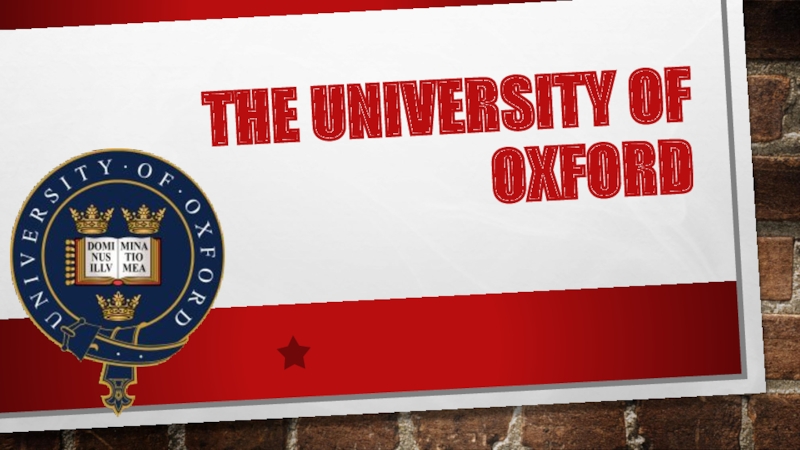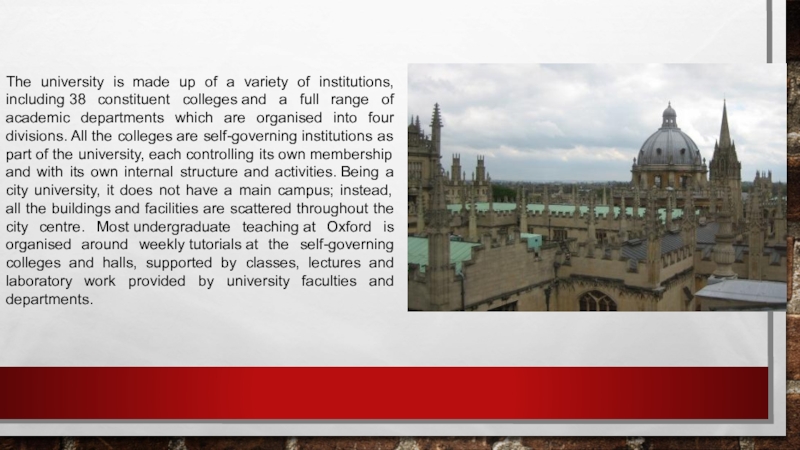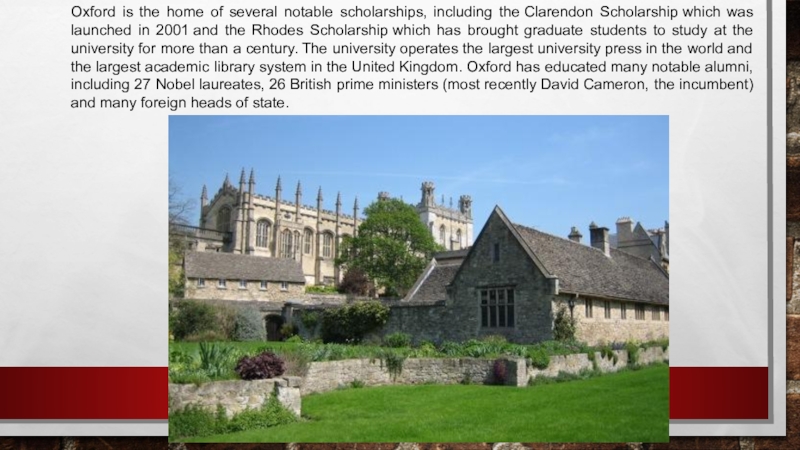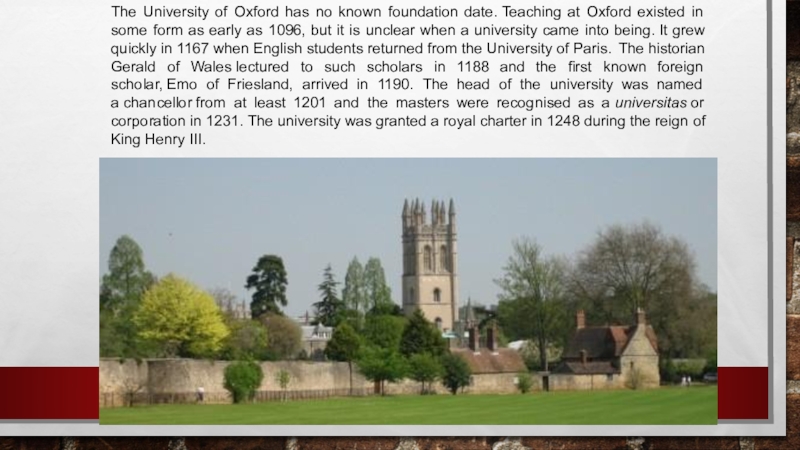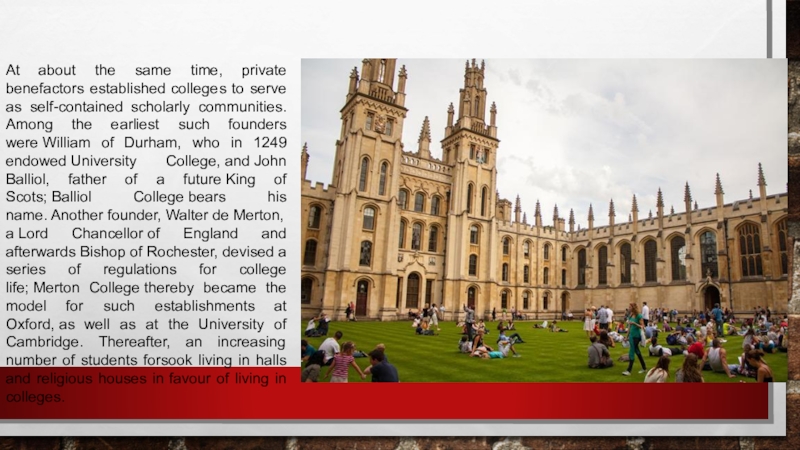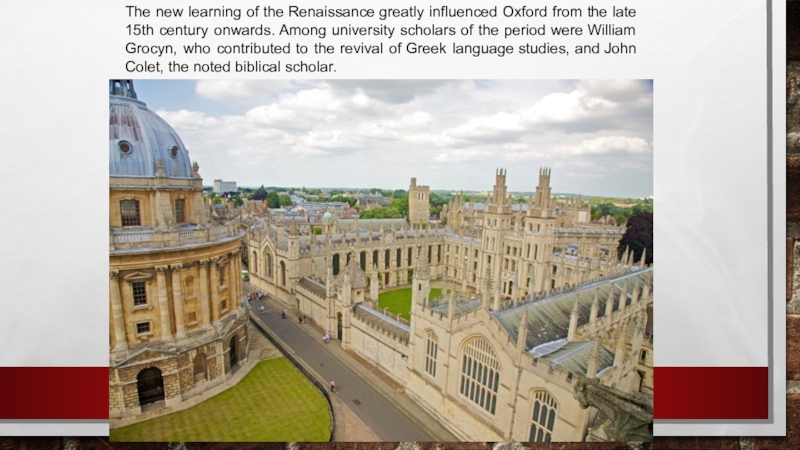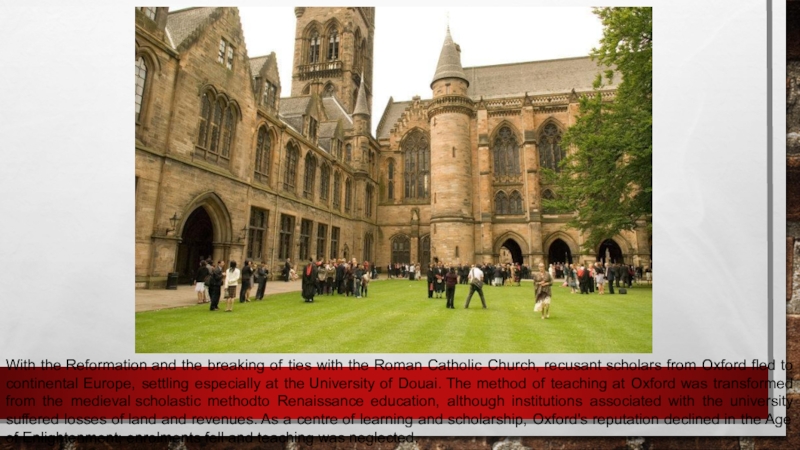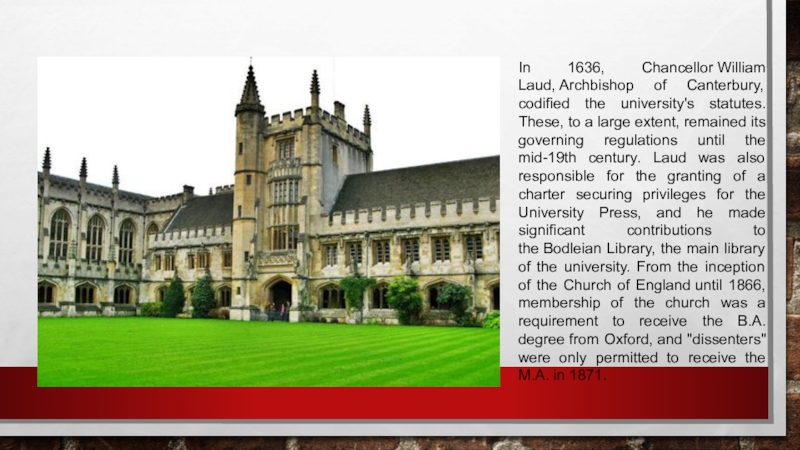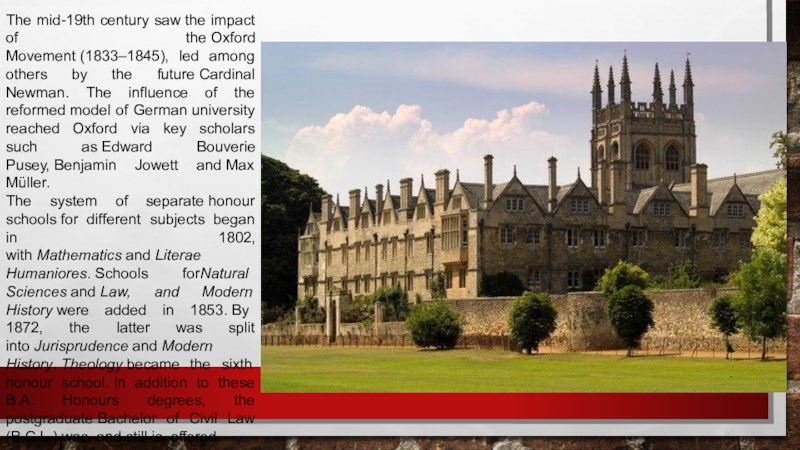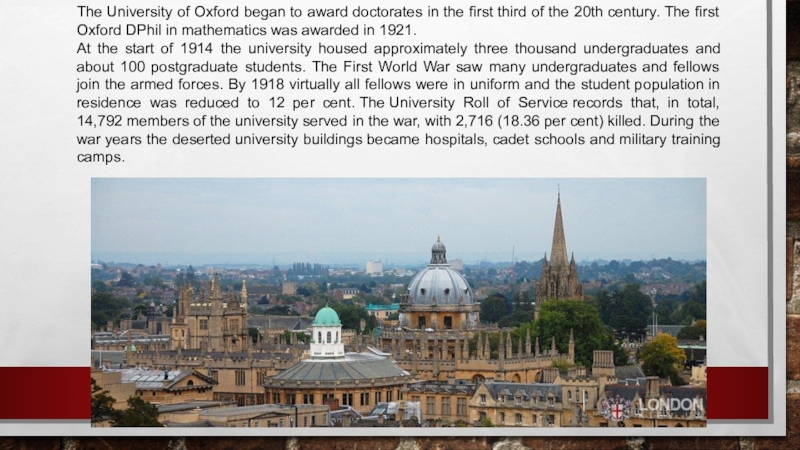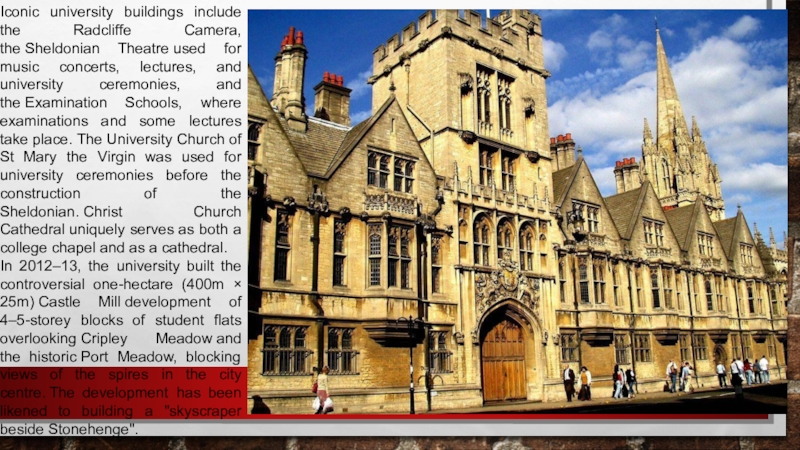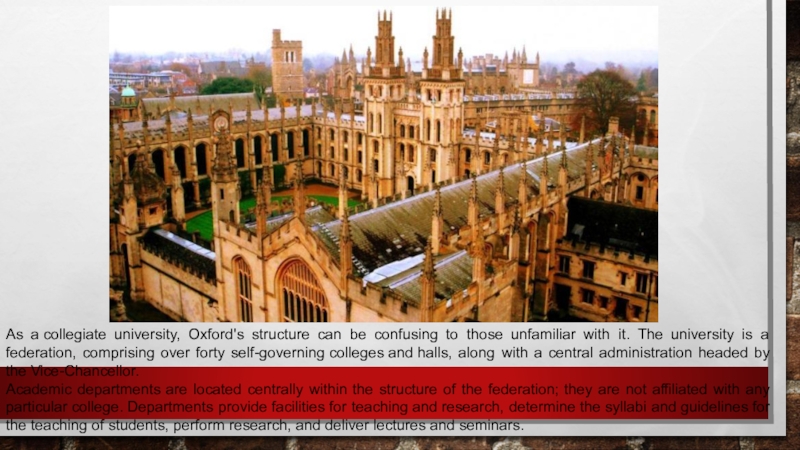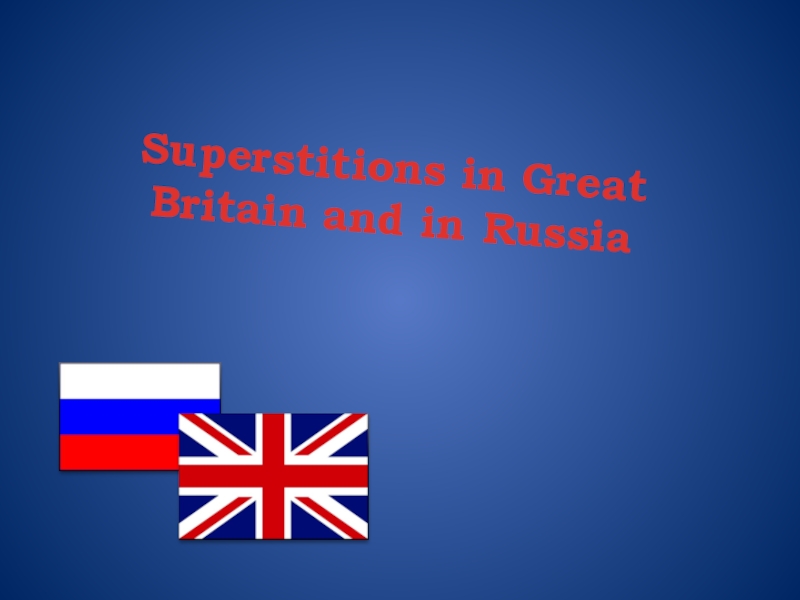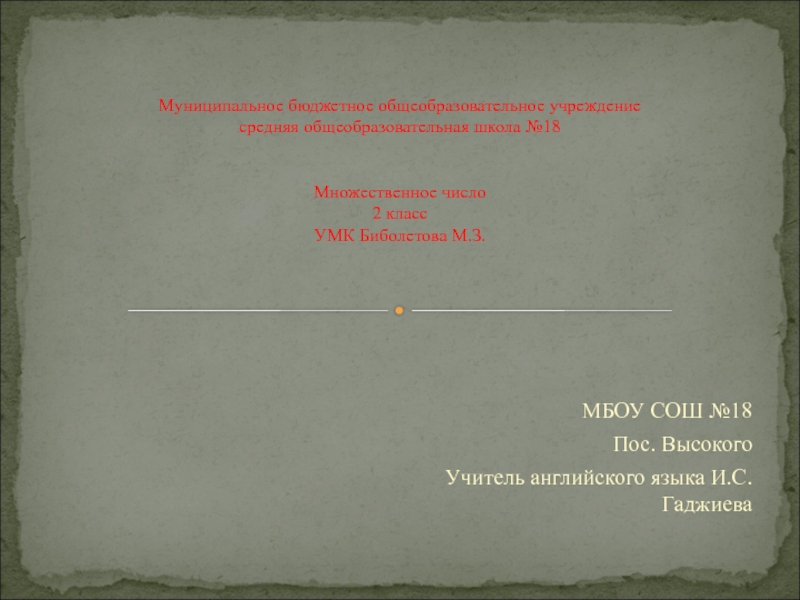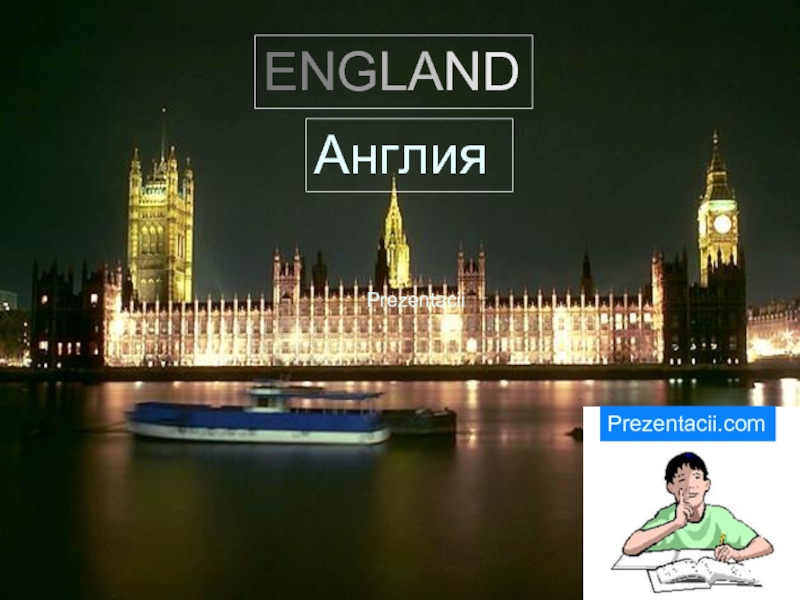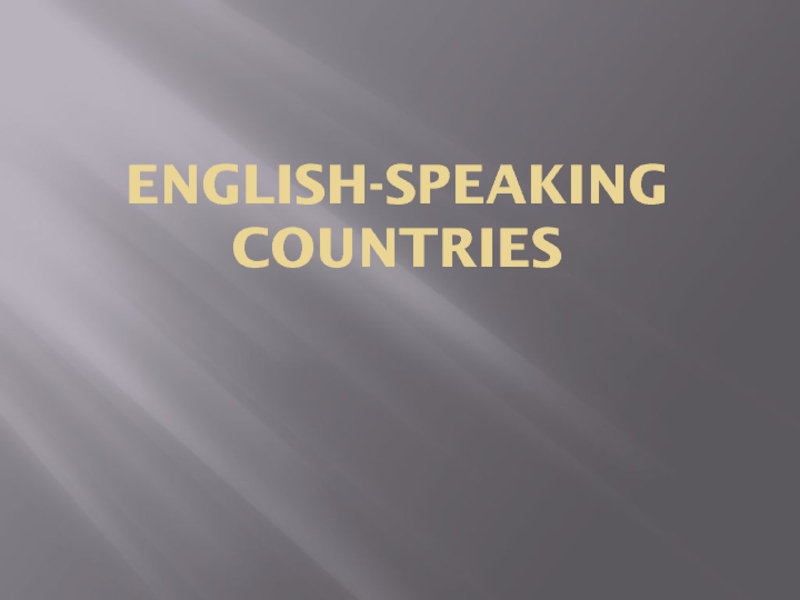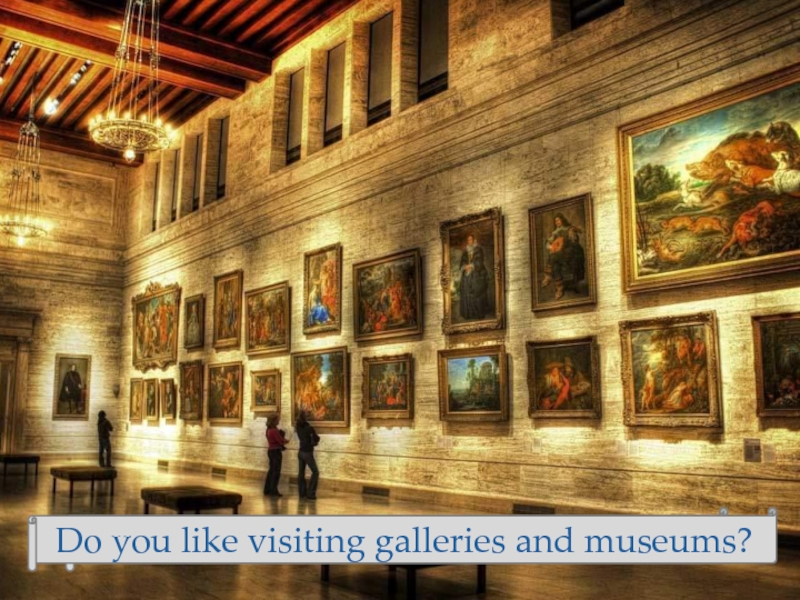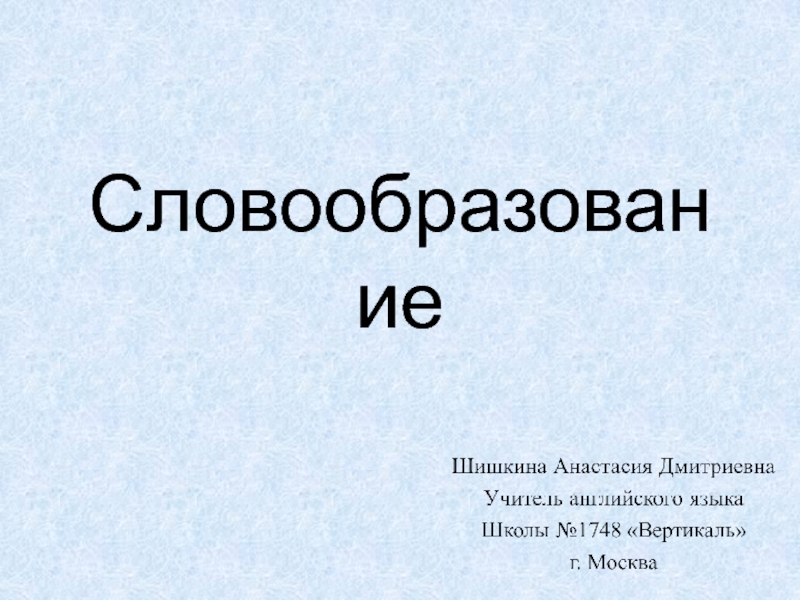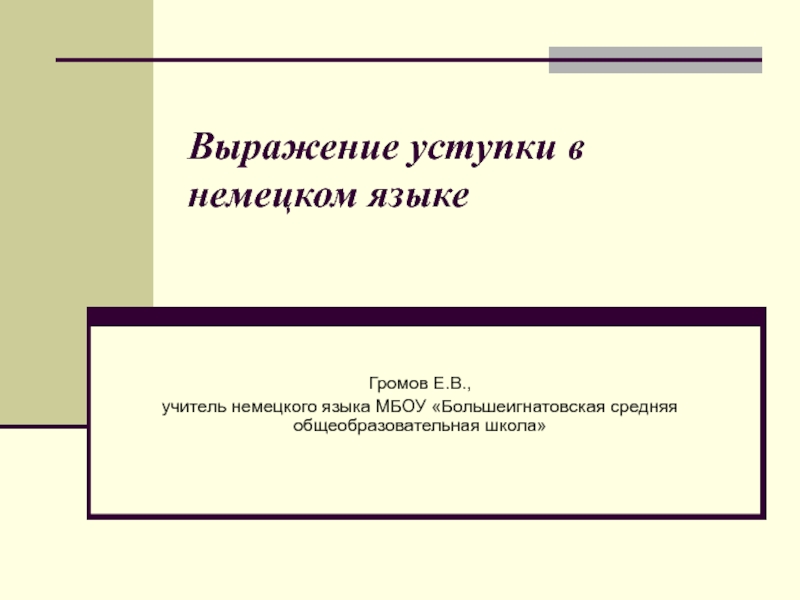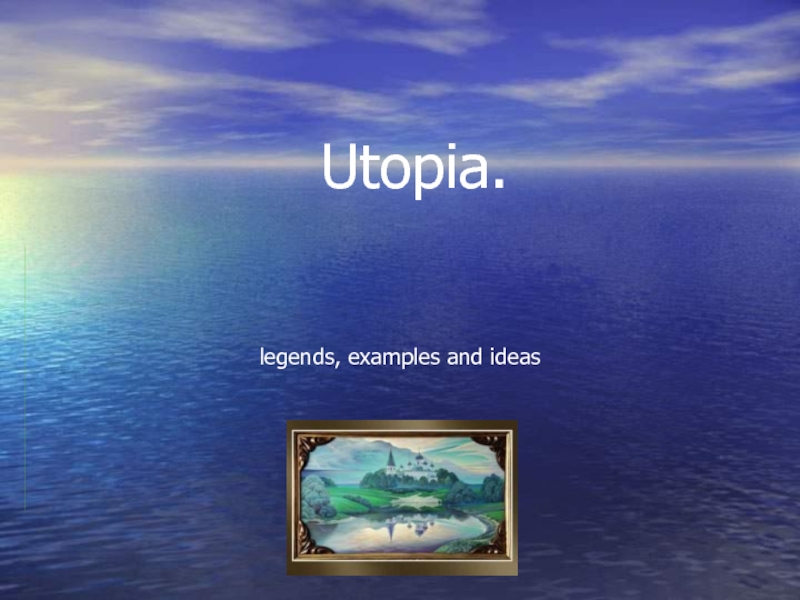Разделы презентаций
- Разное
- Английский язык
- Астрономия
- Алгебра
- Биология
- География
- Геометрия
- Детские презентации
- Информатика
- История
- Литература
- Математика
- Медицина
- Менеджмент
- Музыка
- МХК
- Немецкий язык
- ОБЖ
- Обществознание
- Окружающий мир
- Педагогика
- Русский язык
- Технология
- Физика
- Философия
- Химия
- Шаблоны, картинки для презентаций
- Экология
- Экономика
- Юриспруденция
Презентация для урока английского языка по теме "my future universities"
Содержание
- 1. Презентация для урока английского языка по теме "my future universities"
- 2. Is a collegiate research university located in Oxford, England. While having
- 3. The university is made up of a
- 4. Oxford is the home of several notable
- 5. The University of Oxford has no known
- 6. The students associated together on the basis
- 7. At about the same time, private benefactors
- 8. In 1333–34, an attempt by some dissatisfied
- 9. The new learning of the Renaissance greatly influenced Oxford
- 10. With the Reformation and the breaking of ties with
- 11. In 1636, Chancellor William Laud, Archbishop of Canterbury, codified
- 12. The university was a centre of the Royalist party
- 13. The mid-19th century saw the impact of
- 14. Administrative reforms during the 19th century included
- 15. The University of Oxford began to award
- 16. The mid-20th century saw many distinguished continental
- 17. The university is a "city university" in
- 18. Iconic university buildings include the Radcliffe Camera,
- 19. The University Parks are a 70-acre (28 ha) parkland
- 20. As a collegiate university, Oxford's structure can be
- 21. Colleges arrange the tutorial teaching for their
- 22. To be a member of the university,
- 23. The colleges are:LincolnMagdalenMansfieldMertonNew CollegeNuffieldOrielPembrokeQueen'sSomervilleSt Anne'sSt Antony'sSt Catherine'sSt
- 24. The University of Oxford is the setting
- 25. Other notable examples include:Gaudy Night, a Lord Peter
- 26. Literature:University of Oxford. – Jessie Rassel. Internet resource:https://ru.wikipedia.org/wiki/%D0%9E%D0%BA%D1%81%D1%84%D0%BE%D1%80%D0%B4%D1%81%D0%BA%D0%B8%D0%B9_%D1%83%D0%BD%D0%B8%D0%B2%D0%B5%D1%80%D1%81%D0%B8%D1%82%D0%B5%D1%82http://www.educationindex.ru/institution/university-of-oxfordhttp://www.albioncom.ru/univercity/england/catalog/?id=6
- 27. Скачать презентанцию
Слайды и текст этой презентации
Слайд 3The university is made up of a variety of institutions,
including 38 constituent colleges and a full range of academic departments which
are organised into four divisions. All the colleges are self-governing institutions as part of the university, each controlling its own membership and with its own internal structure and activities. Being a city university, it does not have a main campus; instead, all the buildings and facilities are scattered throughout the city centre. Most undergraduate teaching at Oxford is organised around weekly tutorials at the self-governing colleges and halls, supported by classes, lectures and laboratory work provided by university faculties and departments.Слайд 4Oxford is the home of several notable scholarships, including the Clarendon
Scholarship which was launched in 2001 and the Rhodes Scholarship which has brought
graduate students to study at the university for more than a century. The university operates the largest university press in the world and the largest academic library system in the United Kingdom. Oxford has educated many notable alumni, including 27 Nobel laureates, 26 British prime ministers (most recently David Cameron, the incumbent) and many foreign heads of state.Слайд 5The University of Oxford has no known foundation date. Teaching at
Oxford existed in some form as early as 1096, but
it is unclear when a university came into being. It grew quickly in 1167 when English students returned from the University of Paris. The historian Gerald of Wales lectured to such scholars in 1188 and the first known foreign scholar, Emo of Friesland, arrived in 1190. The head of the university was named a chancellor from at least 1201 and the masters were recognised as a universitas or corporation in 1231. The university was granted a royal charter in 1248 during the reign of King Henry III.Слайд 6The students associated together on the basis of geographical origins,
into two "nations", representing the North (Northern or Boreales, which included the English
people north of the River Trent and the Scots) and the South (Southern or Australes, which included English people south of the Trent, the Irish and the Welsh). In later centuries, geographical origins continued to influence many students' affiliations when membership of a college or hall became customary in Oxford. In addition to this, members of many religious orders, including Dominicans, Franciscans, Carmelites and Augustinians, settled in Oxford in the mid-13th century, gained influence and maintained houses or halls for students.Слайд 7At about the same time, private benefactors established colleges to
serve as self-contained scholarly communities. Among the earliest such founders
were William of Durham, who in 1249 endowed University College, and John Balliol, father of a future King of Scots; Balliol College bears his name. Another founder, Walter de Merton, a Lord Chancellor of England and afterwards Bishop of Rochester, devised a series of regulations for college life; Merton College thereby became the model for such establishments at Oxford, as well as at the University of Cambridge. Thereafter, an increasing number of students forsook living in halls and religious houses in favour of living in colleges.Слайд 8In 1333–34, an attempt by some dissatisfied Oxford scholars to
found a new university at Stamford, Lincolnshire was blocked by the universities
of Oxford and Cambridge petitioning King Edward III. Thereafter, until the 1820s, no new universities were allowed to be founded in England, even in London; thus, Oxford and Cambridge had a duopoly, which was unusual in western European countries.Слайд 9The new learning of the Renaissance greatly influenced Oxford from the late
15th century onwards. Among university scholars of the period were William
Grocyn, who contributed to the revival of Greek language studies, and John Colet, the noted biblical scholar.Слайд 10With the Reformation and the breaking of ties with the Roman Catholic
Church, recusant scholars from Oxford fled to continental Europe, settling especially at
the University of Douai. The method of teaching at Oxford was transformed from the medieval scholastic methodto Renaissance education, although institutions associated with the university suffered losses of land and revenues. As a centre of learning and scholarship, Oxford's reputation declined in the Age of Enlightenment; enrolments fell and teaching was neglected.Слайд 11In 1636, Chancellor William Laud, Archbishop of Canterbury, codified the university's statutes.
These, to a large extent, remained its governing regulations until
the mid-19th century. Laud was also responsible for the granting of a charter securing privileges for the University Press, and he made significant contributions to the Bodleian Library, the main library of the university. From the inception of the Church of England until 1866, membership of the church was a requirement to receive the B.A. degree from Oxford, and "dissenters" were only permitted to receive the M.A. in 1871.Слайд 12The university was a centre of the Royalist party during the English Civil
War (1642–1649), while the town favoured the opposing Parliamentarian cause. From the mid-18th
century onwards, however, the University of Oxford took little part in political conflicts.Wadham College, founded in 1610, was the undergraduate college of Sir Christopher Wren. Wren was part of a brilliant group of experimental scientists at Oxford in the 1650s, the Oxford Philosophical Club, which included Robert Boyle and Robert Hooke. This group held regular meetings at Wadham under the guidance of the College Warden, John Wilkins, and the group formed the nucleus which went on to found the Royal Society.
Слайд 13The mid-19th century saw the impact of the Oxford Movement (1833–1845), led
among others by the future Cardinal Newman. The influence of the
reformed model of German university reached Oxford via key scholars such as Edward Bouverie Pusey, Benjamin Jowett and Max Müller.The system of separate honour schools for different subjects began in 1802, with Mathematics and Literae Humaniores. Schools forNatural Sciences and Law, and Modern History were added in 1853. By 1872, the latter was split into Jurisprudence and Modern History. Theology became the sixth honour school. In addition to these B.A. Honours degrees, the postgraduate Bachelor of Civil Law (B.C.L.) was, and still is, offered.
Слайд 14Administrative reforms during the 19th century included the replacement of
oral examinations with written entrance tests, greater tolerance for religious dissent,
and the establishment of four women's colleges. 20th-century Privy Council decisions (e.g. the abolition of compulsory daily worship, dissociation of the Regius Professorship of Hebrew from clerical status, diversion of colleges' theological bequests to other purposes) loosened the link with traditional belief and practice. Furthermore, although the university's emphasis traditionally had been on classical knowledge, its curriculum expanded in the course of the 19th century to encompass scientific and medical studies. Knowledge of Ancient Greek was required for admission until 1920, and Latin until 1960.Слайд 15The University of Oxford began to award doctorates in the
first third of the 20th century. The first Oxford DPhil
in mathematics was awarded in 1921.At the start of 1914 the university housed approximately three thousand undergraduates and about 100 postgraduate students. The First World War saw many undergraduates and fellows join the armed forces. By 1918 virtually all fellows were in uniform and the student population in residence was reduced to 12 per cent. The University Roll of Service records that, in total, 14,792 members of the university served in the war, with 2,716 (18.36 per cent) killed. During the war years the deserted university buildings became hospitals, cadet schools and military training camps.
Слайд 16The mid-20th century saw many distinguished continental scholars, displaced by Nazism and
communism, relocating to Oxford.
The list of distinguished scholars at the
University of Oxford is long and includes many who have made major contributions to British politics, the sciences, medicine, and literature. More than 50 Nobel laureates and more than 50 world leaders have been affiliated with the University of Oxford.Слайд 17The university is a "city university" in that it does
not have a main campus; instead, colleges, departments, accommodation, and
other facilities are scattered throughout the city centre. The Science Area, in which most science departments are located, is the area that bears closest resemblance to a campus. The ten-acre (4 hectare) Radcliffe Observatory Quarter in the northwest of the city is currently under development. However, the larger colleges' sites are of similar size to these areas.Слайд 18Iconic university buildings include the Radcliffe Camera, the Sheldonian Theatre used for
music concerts, lectures, and university ceremonies, and the Examination Schools, where
examinations and some lectures take place. The University Church of St Mary the Virgin was used for university ceremonies before the construction of the Sheldonian. Christ Church Cathedral uniquely serves as both a college chapel and as a cathedral.In 2012–13, the university built the controversial one-hectare (400m × 25m) Castle Mill development of 4–5-storey blocks of student flats overlooking Cripley Meadow and the historic Port Meadow, blocking views of the spires in the city centre. The development has been likened to building a "skyscraper beside Stonehenge".
Слайд 19The University Parks are a 70-acre (28 ha) parkland area in the
northeast of the city. It is open to the public
during daylight hours. As well as providing gardens and exotic plants, the Parks contains numerous sports fields, used for official and unofficial fixtures, and also contains sites of special interest including the Genetic Garden, an experimental garden to elucidate and investigate evolutionary processes.The Botanic Garden on the High Street is the oldest botanic garden in the UK. It contains over 8,000 different plant species on 1.8 ha (4 1⁄2 acres). It is one of the most diverse yet compact major collections of plants in the world and includes representatives of over 90% of the higher plant families. The Harcourt Arboretum is a 130-acre (53 ha) site six miles (10 km) south of the city that includes native woodland and 67 acres (27 hectares) of meadow. The 1,000-acre (4.0 km2) Wytham Woods are owned by the university and used for research in zoology and climate change.
There are also various collegiate-owned open spaces open to the public, including Bagley Wood and most notably Christ Church Meadow.
Слайд 20As a collegiate university, Oxford's structure can be confusing to those
unfamiliar with it. The university is a federation, comprising over
forty self-governing colleges and halls, along with a central administration headed by the Vice-Chancellor.Academic departments are located centrally within the structure of the federation; they are not affiliated with any particular college. Departments provide facilities for teaching and research, determine the syllabi and guidelines for the teaching of students, perform research, and deliver lectures and seminars.
Слайд 21Colleges arrange the tutorial teaching for their undergraduates, and the
members of an academic department are spread around many colleges.
Though certain colleges do have subject alignments (e.g., Nuffield College as a centre for the social sciences), these are exceptions, and most colleges will have a broad mix of academics and students from a diverse range of subjects. Facilities such as libraries are provided on all these levels: by the central university (the Bodleian), by the departments (individual departmental libraries, such as the English Faculty Library), and by colleges (each of which maintains a multi-discipline library for the use of its members).Слайд 22To be a member of the university, all students, and
most academic staff, must also be a member of a
college or hall. There are 38 colleges of the University of Oxford and six Permanent Private Halls, each controlling its membership and with its own internal structure and activities. Not all colleges offer all courses, but they generally cover a broad range of subjects.Слайд 23The colleges are:
Lincoln
Magdalen
Mansfield
Merton
New College
Nuffield
Oriel
Pembroke
Queen's
Somerville
St Anne's
St Antony's
St Catherine's
St Cross
St Edmund Hall
St
Hilda's
St Hugh's
St John's
St Peter's
All Souls
Balliol
Brasenose
Christ Church
Corpus Christi
Exeter
Green Templeton
Harris Manchester
Hertford
Jesus
Keble
Kellogg
Lady Margaret
HallLinacre
Trinity
University
Wadham
Wolfson
Worcester
Слайд 24The University of Oxford is the setting for numerous works
of fiction. Oxford was mentioned in fiction as early as
1400 when Chaucer in his Canterbury Tales referred to a "Clerk [student] of Oxenford". By 1989, 533 novels based in Oxford had been identified and the number continues to rise. Famous literary works range from Brideshead Revisited by Evelyn Waugh, to the trilogy His Dark Materials by Philip Pullman, which features an alternate-reality version of the university.Слайд 25Other notable examples include:
Gaudy Night, a Lord Peter Wimsey mystery by Dorothy L.
Sayers (who was herself a graduate of Somerville College).
The Inspector Morse series by Colin Dexter,
and its spin off Lewis, are set in Oxford and frequently refer to the university (although most of the college names are fictional).Zuleika Dobson, by Max Beerbohm
Brideshead Revisited (1981), based on Waugh's novel; a miniseries enormously popular in Britain and America, the film has sometimes been seen as drawing unwanted attention to Oxford's stereotypical reputation as a playground of the upper classes. It stars Jeremy Irons and most college shots are of Christ Church and Hertford.
True Blue (1996), about the mutiny at the time of the Oxford-Cambridge Boat Race of 1987
The History Boys (film) (2008) movie about a group of boys applying to do history at Oxford. Set in 1983 and based on the play by Alan Bennett.
The Golden Compass (film) (2007)
The Riot Club (2014)
